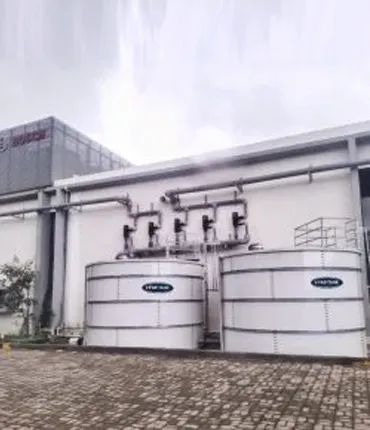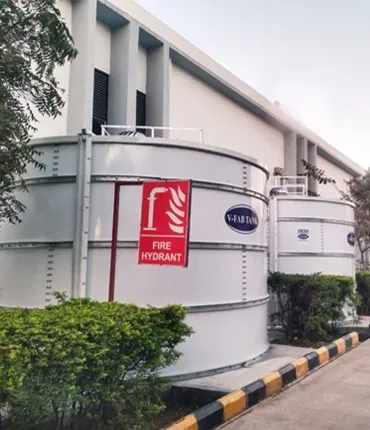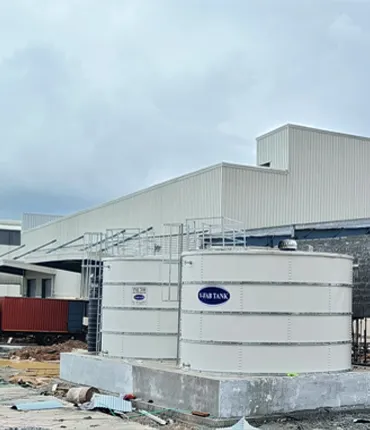Rain water Harvesting Tanks
Design And Manufactures Of Rain water Harvesting Tanks, Fabricated Storage Tanks, Prefabricated Tanks, Fire Tank, Raw Water Storage Tanks, Overhead Water Tanks, Rainwater Harvesting Tanks, Industrial Wastewater.
Rain water Harvesting Tanks : Manufacturer, Supplier.
Driven by our commitment to excellence across every aspect of our business, VFAB Tanks has established a strong foothold in both domestic and international markets. Our products are crafted using superior raw materials and sustainable engineering practices, ensuring innovative solutions that align with quality standards. We specialize in the manufacturing and supply of variety of water storage tanks such as raw water storage tanks,de-mineralized water storage tanks,potable water storage tanks and many other associated products.
When the local water source is insufficient or inconsistent, a large supply of water will need to be maintained on site in the event of a fire. FM Approved fire water storage tanks are intended to provide a reliable repository for the water for the fire protection system. FM Approvals water tanks are evaluated from a structural standpoint including earthquake, wind resistance and roof loads.
Benefits of Rain Water Harvesting Tanks
- Reduces Water Bills - Rainwater harvesting tanks lower reliance on municipal water systems, cutting costs for individuals and communities by providing a free and sustainable water source.
- Decreases Groundwater Demand - By utilizing rainwater, these tanks help conserve groundwater reserves which are increasingly strained due to overuse and environmental changes.
- Minimizes Flooding and Erosion - Collecting rainwater reduces storm water runoff, preventing soil erosion and reducing urban flooding risks.
- Promotes Environmental Conservation - Rainwater harvesting reduces the energy required for municipal water treatment and distribution, thereby lowering carbon emissions and supporting eco-friendly practices.
- Improves Groundwater Recharge - Stored rainwater can renew groundwater storage, enhancing groundwater levels and ensuring water availability in drought prone areas.
- Provides Chemical Free Water - Rainwater is naturally soft and free from chemicals like chlorine or fluoride, making it ideal for irrigation and other non-potable uses.
Application Industries Rain Water Harvesting Tanks
- Agriculture - Rainwater harvesting tanks are widely used in agriculture to provide irrigation water for crops, specially in areas facing groundwater depletion or drought conditions.
- Residential Sector - These tanks are installed in homes to collect rainwater for non-potable uses such as laundry, flushing toilets and gardening, promoting water conservation at the household level.
- Commercial Buildings - Commercial establishments use rainwater harvesting systems to manage storm-water runoff and reduce their dependency on municipal water supplies for landscaping and sanitation.
- Industrial Applications - TIndustries utilize rainwater harvesting tanks for cooling systems, cleaning processes and other operational needs, reducing water costs and environmental impact.
- Public and Municipal Projects - Municipalities install rainwater harvesting tanks to address urban flooding, refill underground water reserves and ensure water availability for public spaces like parks and community centers.
Why Choose Us Rain water Harvesting Tanks?
- Integrity - The company operates with honesty and transparency in all its dealings, ensuring trust with customers. This ethical approach guides every business decision relating to all products including rain water harvesting tanks.
- Sustainability - The company prioritizes sustainable practices in manufacturing and operations for all its tanks to minimize environmental impact.
- Reliability - The company delivers high quality rain water harvesting tanks that consistently meet customer expectations, developing long term relationships. Its products are designed to perform reliably over time.
- Continuous Improvement - The company continuously updates its processes and products such as rain water harvesting tanks,to stay ahead of industry standards. This focus on innovation ensures better solutions for customers.
- Engineering Precision - The rain water harvesting tanks are crafted with precise engineering to ensure durability and efficiency. Every detail is meticulously considered to meet specific needs.





Product Details of Rain Water Harvesting Tanks
Rainwater harvesting tanks are integral components of systems designed to collect,store and manage rainwater for future use. These tanks are usually classified into above ground and underground types, depending on their placement relative to the surface. Above ground tanks are typically used for collecting rainwater from rooftops, whereas underground tanks are ideal for capturing runoff from ground-level catchment systems.The construction materials for these tanks vary and include reinforced cement concrete, Fiberglass reinforced plastic,brick or masonry, polyethylene or stainless steel.
The choice of material depends on factors like durability,cost and the specific environmental conditions of the installation site. Underground tanks must be designed to withstand soil and water pressure when empty and should be sealed to prevent contamination from surface or groundwater. Above ground tanks are easier to access for maintenance but may require additional structural support.
The design of rainwater harvesting tanks is influenced by several factors including the size of the drainage area, local rainfall patterns, anticipated water usage and the projected duration between rainfall events. The capacity of the tanks must be adequate to meet these requirements while ensuring efficient storage without overflow or wastage. Proper filtration systems are essential before water enters the tank to remove debris,dust and pollutants. Common filters include charcoal filters, sand filters and mesh screens. Maintenance of rainwater harvesting tanks is crucial for ensuring their longevity and water quality. Regular cleaning is necessary to remove accumulated sediment and debris from both the tank and associated components like gutters and pipes. Annual inspections should check for cracks or leaks in the tank structure and ensure that pumps and taps are functioning correctly.